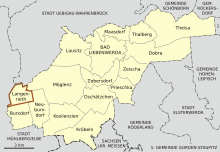Langenrieth
Long Rieth is on the green heath situated district of the city Bad Liebenwerda in Elbe-Elster in Brandenburg and is located eleven kilometers southwest of the city.
Langenrieth belonged to the Bad Liebenwerda district until its incorporation in 1993 and has around 150 inhabitants.
history

It was first mentioned in documents in 1323 and goes back to the transfer of four Hufen land near Langenrieth by Rudolf II and his brother Wenzel I to the monastery in Mühlberg . From 1324 the place belonged partly to the Mühlberg monastery. The residents of Langenrieth have always been farming and raising animals.
In 1540 the place was named as a branch of Koßdorf (before it belonged to the Boragk parish ) and from 1550 it belonged to the Mühlberg office . 1586 a leased Mühlberger citizens the convent Guildenstern in Muhlberg, together with the outworks Long Rieth and Wendisch-Borschütz . From 1619 to 1621 a half-timbered church was built in Langenrieth . In the Thirty Years War the place was devastated except for the church, which was spared.
In 1749 Heinrich von Brühl bought the Vorwerk Langenrieth property, which from then on belonged to the Martinskirchen manor until 1945 . During the Wars of Liberation in September 1813 French troops encamped around the place.
In 1816 145 people lived in Langenrieth and in 1835 the place had 23 houses and 153 inhabitants with 22 horses, 155 cattle, 213 sheep, 8 goats and 50 pigs.
In 1842 a new school was built in Langenrieth and from 1912 to 1913 the old dilapidated half-timbered church was demolished. A new village church was built in the same place during the same period. In 1919 the Höhne brothers built the new mill and in 1934 the volunteer fire brigade was founded.
In the First World War were fourteen, in the Second World War, thirteen local residents.
From 1945 to 1950, 18 new farmer positions were created in Langenrieth . The population increased to 236 by 1956. On January 1, 1977 Langenrieth became part of the community of Neuburxdorf and in 1993 Neuburxdorf was incorporated into Bad Liebenwerda together with other places .
In 1960 LPG Type I was founded with 10 companies.
One of the two bells in Langenrieth's church was melted down during World War II. A replacement bell from Koßdorf turned out to be a stop bell and could therefore not be used to ring. In March 2009 the parish received a new bell. The new bell was created in the Lauchhammer art and bell foundry and installed in October 2009.
traffic
The Langenrieth stop was on the Neuburxdorf – Mühlberg railway line, which was no longer used .
Personalities
- Walter Gabriel (1887–1983), German Protestant theologian, member of the Confessing Church (BK) and prisoner in the Dachau concentration camp, parish administrator in Langenrieth
literature
- Wolfgang Eckelmann, Michael Ziehlke: Chronicle of the city of Liebenwerda. Edited by Association for City Marketing and Economy Bad Liebenwerda eV Winklerdruck GmbH Gräfenhainichen, Bad Liebenwerda 2007, p. 254 to 255 .
Individual evidence
- ↑ Population development in the city of Bad Liebenwerda and its districts in recent years. (pdf; 48 kB) Archived from the original on November 30, 2012 ; Retrieved July 22, 2013 .
- ^ "Overview of the population and the cattle stock in 1835" in "The Black Elster - Our home in words and pictures" . No. 596 . Bad Liebenwerda 1985, p. 8 to 10 .
- ↑ Lausitzer Rundschau, March 9, 2009, local edition Bad Liebenwerda, Elsterwerda, Wahrenbrück, Plessa, Röderland, Mühlberg and Schradenland
Web links
Coordinates: 51 ° 28 ' N , 13 ° 16' E

